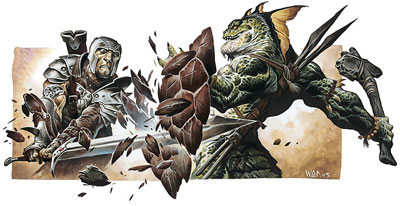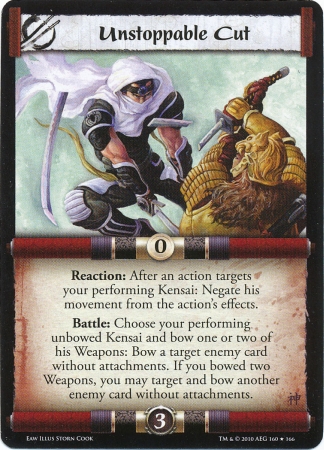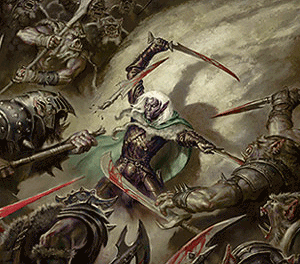

| Damage to armor | - | Damage to weapons | - | The ravages of rust and time |
| Dragon | - | Best of Dragon, Vol. IV | - | Dragon 73 |
Why don?t heroes ever seem to spend
time sharpening their swords? Everybody
e l s e h a s
t o . H o w c o m e T h e o b a l d
t h e
Magnificent never gets his shield banged
u p , o r h i
s s w o r d n o t c h e d , o r
h i s h e l m
cloven? Wear and damage to equipment
are concerns of every fighter making his
w a y i n a
m u t a b l e w o r l d , b u t n o
t , i t s e e m s ,
of characters in the AD&D?
world.
T h e s i m p l e
f a c t i s , t h o u g h , t h a t
nothing lasts for ever. And without spec
i a l c a r e , n o t h i n g l a s
t s a s l o n g a s i t
should. Arms and armor are not exceptions.
Sharp edges, to stay that way, must
be honed occasionally. Nicks and dents
h a v e t o b
e f i x e d . R u s t w i l l
g e t y o u s o o n e r
o r l a t e r ,
e v e n i f y o u s e n t
a l l y o u r e q u i p m e n t t o
Z - B a r t . F o l l o w i n g a r e
s o m e s u g gestions for easily implemented rules to
add this dimension to your game.

W h e n a c o m
b a t a n t r o l l s a natural
20 in
melee, his or her opponent (if armored)
must roll a a
saving throw for his armor vs.
crushing blow.
The armor gets magical
plusses (if any) as bonuses to this save,
plus any other bonuses that might apply.
A shield, if one is being used by the character
or creature that is hit, will take
damage until it is rendered useless; after
that, the armor itself will absorb the
blows. Failure to make this saving throw
means one's shield is broken (or at least
severely damaged), or one's armor is rent.
Armor and shields can absorb as many
dents and rents as the number of AC factors
the item provides. Thus, a shield will
take 1 good blow before it is broken
(same for a helm);
leather
or padded
armor will absorb 2 such blows before
it is useless for protective purposes;
ring
mail can take 3 blows, studded leather
three, scale mail 4, chain mail 5,
splint mail or banded mail 6, and plate
mail 7.
Magick armor adds absorption
ability according to its magical bonuses;
for instance, chain mail +2
will absorb
seven blows before it becomes useless.
Each time a piece of armor absorbs a
blow, by failing to make the save, its
AC
protection drops by one factor. Chain
mail (AC 5) becomes chain mail -1 (AC
6), then -2, and so on. A shield
+1 does
not cease to be magical, but it drops
to a
shield +0 after taking such a wallop,
and
then is a ruined, unmagical shield after
one more damaging blow. Damaged
armor will stay so until repaired by
someone skilled in the craft. The cost,
in
gold pieces and time, of such repair is
a
minimum of 3 days and 25 g.p. for each
damaging blow the armor has absorbed.
Magic armor cannot be repaired by an
ordinary armorer or smith without its
losing its dweomer.

When a combatant rolls a natural
1 in
combat, his weapon is adversely affected.
An edged weapon becomes notched each
time a 1 is rolled, and it takes a -1
penalty
"to hit" and to damage. A normal sword
becomes a sword -1. A magical sword
+1
becomes a magical sword +0.
Magical
edged weapons get a
saving throw vs.
crushing blow
(non-magical edged weapons do not). No edged weapon can be
reduced to the point where one cannot
possibly hit with it, nor to the point
where it can do no damage. Thus, it cannot
take any more ?hits? beyond the
point where it takes a roll of 20 to hit
with it, or below the point where it does
at least 1 point of damage.
A character who rolls a natural 1 while
attacking with a blunt weapon will find
that the weapon has slipped from his
hand.
A pole arm or staff will crack on a roll
of 1. A saving throw must be rolled each
round thereafter vs. crushing blow. Failure
to save at any time means the haft
snaps.
A strung weapon will snap a string,
and thus misfire, on a roll of 1. A weapon
with a wet string need only roll a natural
2 for the string to snap.
A hurled weapon is not damaged the
way other types might be, but rolling
a
natural 1 means that the wielder
(thrower) of the weapon may be temporarily
off balance. Unless the wielder
(thrower) rolls his dexterity or less
on
d20, he is off balance, loses all dexterity
and shield AC for bonuses that round,
and is -(1-4) in rolling for initiative.
(That is to say, he loses 1-4 segments
from
whatever his party rolls for initiative.)
A fighter engaged in combat without
weapons occasionally might not use the
weaponless combat table. In this case
(when, essentially, the fighter?s bare
fist is
treated as a weapon), a roll of natural
1 is
considered the same as a result for a
hurled missile, described above. That
is,
the fighter is off balance, and must roll
d20 vs. his dexterity or suffer the same
penalties as for a hurled weapon that
goes
awry.
If a character neglects to have his
swords and such attended to, or his armor
gone over by an armorer
at least four
times a year, then the DM can assess the
user of that equipment a penalty of -1
on
every saving throw rolled for the equipment,
due to neglected rust and wear and
tear. This deficiency can be remedied
by
simply having the equipment seen to
(cleaned, polished, etc.). At the DM?s
option, the same penalty may be applied
for every week spent in a tropical or
marsh environment (or the like) without
the character cleaning his equipment.
It
takes a full day to go over an entire
suit of
armor and all of one?s weapons ? but it?s
a day well spent.